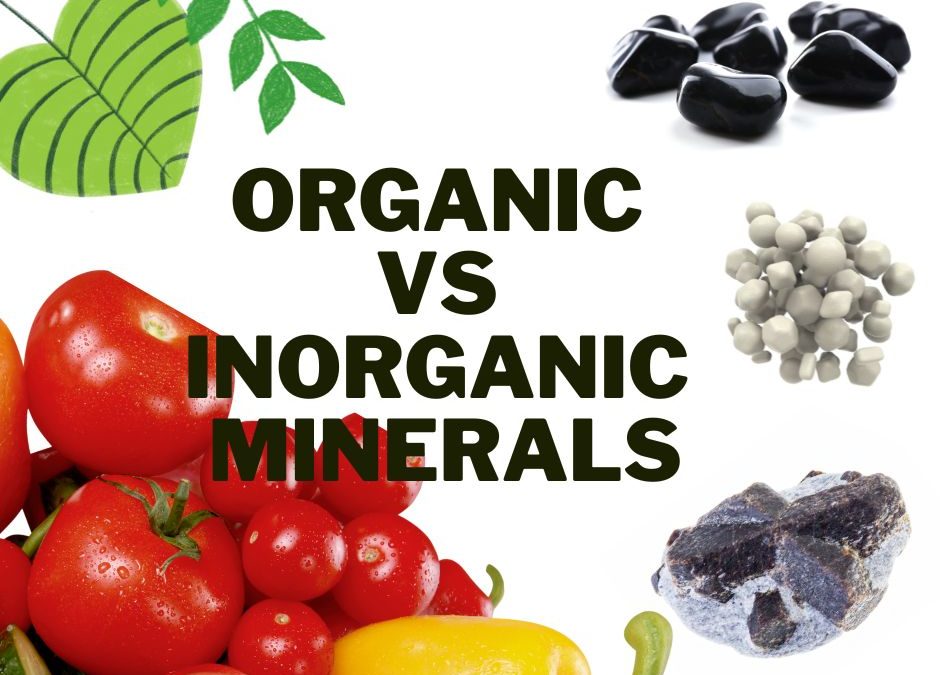
Fluoride in Drinking Water
31/08/2022
Distilled water leach minerals?
31/08/2022Organic vs Inorganic minerals?
This is a HOT topic. You will see people on the Internet talking about organic vs inorganic minerals. Do we get them the water we drink or from our food?
We think this video by Dr Berg is best to explain the differences in less than 5 minutes.
What are Organic Minerals?
Before we delve too deep, it’s a good idea to understand what we mean when we’re talking about an organic mineral. After all, the term itself seems to be contradictory, how can a mineral be organic? In this context, when we refer to a mineral as being organic, it means that the specific element is bonded to a carbon atom. Carbon is also an organic element, and all living creatures are carbon based lifeforms. So, a bond with a carbon atom could, in theory, make any element bioavailable and thus usable by a living organism. This is only conjectured at this point, and further research is needed to prove this theory.
We do know that our bodies are composed of 70% water, our mineral sources in nature have always been water based and sourced from the water we drink and the food that we eat. Organic minerals were once or are still alive, and their electrons (like those in a human body) spin in a clockwise direction. The cells in an organic mineral can form ionic bonds with the body, and they can break down to assist in bodily functions, including tissue repair.
What are Inorganic Minerals?
An inorganic mineral is a material that has never been alive; it has not been bonded with carbon, and it could never bring life to a cell. In fact, the body will treat these materials or metals as if they are a toxin. An inorganic mineral is tightly wound, and it cannot break down easily to assist the body. The electrons in this material spin in a counterclockwise direction and this makes them fundamentally out of sync with a human body.
Inorganic materials in nature are often removed from water by evaporation, where only the water is removed, leaving the inorganic minerals and chemicals behind. The nature’s rain processes this natural phenomenon to give us a purer and safer drinking water.
As our water runs through the ground inorganic minerals are picked up and carried along. Water is an extremely effective solvent, and many materials can be easily dissolved in it. Inorganic minerals cannot be used by a human or animal life form, but plants can use these materials. In fact, plants are the organisms that can turn this material into an organic mineral via photosynthesis, but this is in no way beneficial in our drinking water.
Minerals are typically inorganic:
Sodium Chloride (salt) and Calcium Carbonate (limescale) are examples of (inorganic) minerals. There is a class of chemicals called organic minerals, for example, carpathite, amber, oxammite, calclacite – these are not used by the body.
The only organic mineral which has any role in human biology is urea which is formed by the breakdown of protein and is excreted by the body.
There are a lot of people who refer to “organic minerals” and include compounds like Methionine and Cysteine. These are not “organic minerals” they are amino acids which are the building blocks of proteins. They are useful to the body but they are not “organic minerals”.
The five major minerals in the human body are calcium, phosphorus, potassium, sodium, and magnesium.
All of the remaining elements in a human body are called “trace elements”. The trace elements that have a specific biochemical function in the human body are: sulphur, iron, chlorine, cobalt, copper, zinc, manganese, molybdenum, iodine and selenium.
The Dangers of Inorganic Minerals
Inorganic minerals and chemicals can harm us because they cannot be absorbed as a source of nutrition in our cell wall like organic minerals. But, this material has to go somewhere, so it gets deposited elsewhere in our bodies. These inorganic mineral deposits can cause a variety of health related issues depending on where they end up, such as clogged arteries, arthritis, gallstones, kidney related issues, and joint pains. A common inorganic mineral found in drinking water is Lime or calcium carbonate, and this is the same tough material found in cement. People that ingest large quantities of Lime can suffer from disfigured hands and fingers that are extremely painful.
An expert in this field, Dr. Norman W. Walker wrote a book on this subject. He discovered that a person drinking 1L of water each day over a seventy year period would ingest 90-136 kg of rock, which would include materials, such as magnesium and lime, that a human body simply cannot use. A great deal of this inorganic mineral material would be eliminated via excretory means, but some would still remain, and they could be a source of some of the health problems we mentioned earlier.
So, do you have any of these inorganic minerals present in your water supply? There is a simple experiment that you can carry out at home to check if you have a problem. Get a pot and fill it with tap water, leave it out in the sun and let the water evaporate away. As we mentioned above, this will only remove pure water or hydrogen, and oxygen and everything else will be left behind. If you discover that your pot contains mineral deposits, you may want to explore your water treatment options.
Which is the Best Mineral Source?
There are some people that say that we can only use mineral elements if they are sourced from the food we eat, which would make them organic minerals. Others are adamant that ground rock based inorganic minerals are the best way to fulfill all of our mineral needs. There are even people that propose that liquid mineral sources, such as ionic supplements, sea water, and natural mineral water, are the best choice for health.
Sadly, thanks to pollution it would be extremely risky to drink seawater or water sourced directly from a mineral stream. Also, many of the foods that are grown today are somewhat deficient in many of the organic minerals that we need to stay healthy. This has occurred because of modern farming methods that use chemical fertilizers, pesticides and a lack of soil replenishment. Much of our food is processed to the point where it has little to no beneficial mineral and nutrient content.
Conclusion: The very best option available to us right now is to have a source of water clean from inorganic minerals. This can be achieved by ordering Pure Water or installing a water purifying systems in your home. Organic whole foods should be eaten wherever possible to gain the maximum amount of organic minerals and nutrients possible. It’s also a good idea to supplement this healthier diet with a good ionic mineral supplement.
Related posts
29/09/2025
31/08/2025




